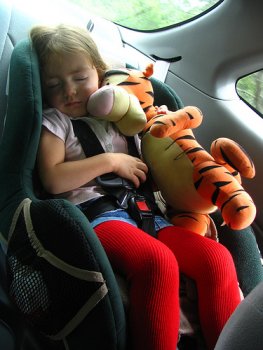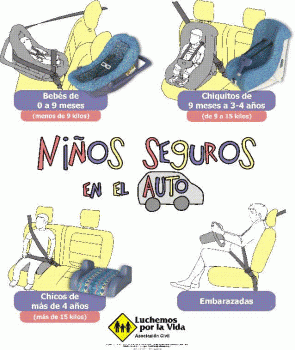Seat belt
Everybody must use seat belts
All the occupants of the vehicle must buckle up, also children and people who are travelling in rear seats.
The seat belt that is buckled up properly must pass ahead of the shoulder, over the clavicle, the chest and the hips, at the height of the pelvis, preventing that it puts pressure on the high part of the abdomen. The youngest ones must travel in their special child restraint systems.

- Usefulness of Seat belts
It is the best life-saver in case of an accident. When passengers travel in the vehicle, they are moving at the same speed than the vehicle although they don’t feel it. But, in case of an abrupt stop, everything that is not tied inside the car will keep on its journey ahead, as a consequence of the physical law of the inertia and it will stop only when it hits against something (it may be the instrument board, the windshield, the ground, and so on).
Anyone may have experienced a slight sensation of this during a bit abrupt stop. Indeed, in an abrupt stop, the bag or the briefcase that are on the seat fall down, or the sack with drinks falls over.
- What happens in a crash at 50 km/h?
The car stops against the obstacle abruptly. And its occupants’ bodies keep on moving ahead at the same speed that the car was moving until that moment, propelled by an enormous strength, that is equal to 40 times the weight of each person, spread out in the abrupt deceleration. If they are not buckled up, they will hit against the instrument board and the windshield. And people who are in rear seats will be propelled, with this same strength, towards the frontal part. They will hit the passengers on the frontal seats and the frontal part of the vehicle. Eventually, they could be thrown away from the vehicle, increasing six times the possibilities of dying, when they hit against the ground or any hard object.
Any object inside the car -for example a cell phone-, no matter how small it is, will hit the occupants and against the windshield and the instrument board if it is not tied. This could produce serious injuries. An extinguisher which is untied or bad fixed inside the vehicle could be a fatal projectile in case of an accident. It must be placed near the driver, inside the car, with a bracket that not only prevent its detachment and ensures its permanency and fixation even in case of crash or overturn, but also makes possible its use easily. It mustn’t be fixed over the studs of the roof. Make sure that you are not carrying any untied, sharp or heavy, object, that might injure some in case of an abrupt stop or crash.
- Children in the car
For this, it is very important that oldest kids and adult people buckle up and the youngest kids travel buckled up in their child restraint systems because, due to their size and bone structure, seat belts don’t protect them properly. There are different types of child restraint systems for babies and kids that are suitable for their size and physical conditions. It is very important to choose the correct model and to put the kid well seated and correctly buckled up in the child restraint system, with the belts of its. Besides, the child restraint system must be well fixed to the vehicle with its seat belt. Law in force establishes that children under ten years old must 
For babies from 0 to 9 months (less than 9 kg): these restraint systems must be placed oriented backwards.
For children from 9 months to 3-4- years old (from 9 to 18 kg): The child restraint systems is placed oriented towards ahead and must be changed as the kid grows up.
For children who are from 3-4 to 6-7 years old (more than 15 kg): They must travel seated in their child restraint systems and the older ones can use the seat belt, but they must sit on a pillow so that one of the ribbons of the seat belt passes ahead of the hip, not in the high part of the abdomen and the superior belt passes through the middle of the clavicle.
- Pregnant mum
She must protect herself and the baby who is about to be born, always using the seat belt, and taking into account that the belt must be placed on the pelvis, below and over the abdomen, as the picture shows.
‘

